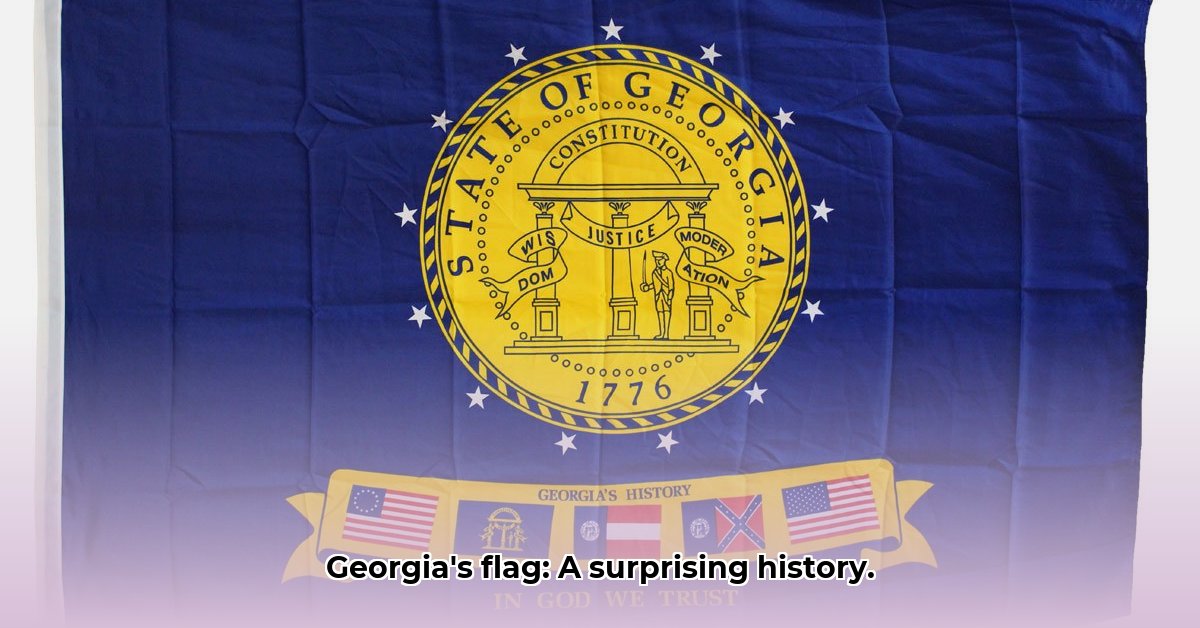The Georgia state flag, a vibrant emblem of red, white, and blue, stands as a silent yet powerful narrator of the state’s intricate journey. Its design, far from static, has undergone a metamorphosis mirroring Georgia’s complex and often turbulent history. From its colonial infancy to its current iteration, the flag has served as a canvas upon which social, cultural, and political narratives have been painted, erased, and repainted. This exploration delves into the flag’s fascinating evolution, unraveling the controversies, compromises, and enduring debates that have shaped its symbolism and continue to resonate today. For more on early American flags, see this resource on early American flags.
Genesis of an Emblem: Georgia’s Early Flags
Georgia’s earliest flags, emerging during its colonial era and the nascent years of the United States, possessed a relative simplicity. Often consisting of basic stripes and stars, these initial designs primarily symbolized the state’s newfound place within the burgeoning nation. These early flags, however, lacked the layered symbolism and potent emotional charge that would later define the flag’s narrative. This simplicity reflected a young state still forging its identity, a period before the flag became a contested symbol embroiled in complex social and political currents. One prominent early example, raised in Savannah in 1860 amid the rising tide of secessionist sentiment, featured a coiled rattlesnake on a white field with the inscription “Our Motto, Southern Rights, Equality of the States, Don’t Tread on Me.” This flag, predating the Confederacy, already hinted at the brewing tensions that would soon engulf the nation.
The Confederate Shadow: A Divisive Legacy
The mid-19th century cast a long shadow over the Georgia state flag, inextricably linking it to the Confederacy and the divisive legacy of slavery. In 1956, amidst the struggle for civil rights and the backlash against desegregation, the state adopted a flag prominently incorporating the Confederate battle flag. This decision ignited a firestorm of controversy, transforming the flag into a potent symbol of racial division and historical trauma for many Georgians. The Confederate battle flag’s inclusion resonated far beyond a mere design choice; it became a lightning rod for deeply entrenched beliefs about heritage, race, and the enduring wounds of the Civil War. The flag, in essence, became a visual embodiment of a fractured society grappling with its past.
Navigating the Aftermath: Post-Civil War Flag Transformations
The aftermath of the Civil War ushered in an era of introspection and a struggle for reconciliation in Georgia. Repeated attempts were made to modify the state flag, either by removing the Confederate battle flag entirely or by mitigating its prominence. This period witnessed a series of redesigns, each reflecting the ongoing tension between honoring Confederate history and fostering a more inclusive state identity. The evolving designs mirrored the state’s internal conflict, a testament to the enduring challenges of forging unity and healing the deep divisions wrought by the war. One notable attempt at compromise came in 2001 with a design featuring miniature versions of past Georgia flags, including the 1956 version, under the banner “Georgia’s History.” However, this design, often derisively referred to as the “Barnes rag,” failed to gain widespread acceptance and was short-lived.
The 2003 Compromise: Seeking Common Ground
The current Georgia state flag, adopted in 2003, emerged from a renewed effort to find common ground. This design draws inspiration from the first national flag of the Confederacy, the “Stars and Bars,” but replaces the Confederate stars with a ring of thirteen white stars encircling the Georgia state coat of arms. The inclusion of “In God We Trust” further reflects the state’s cultural and political landscape. While intended as a compromise, the 2003 design has not entirely escaped the shadow of controversy. Critics argue that its resemblance to the “Stars and Bars” perpetuates the association with the Confederacy, while supporters emphasize the inclusion of state symbols and the removal of the explicit Confederate battle flag.
A Symbol in Flux: Ongoing Dialogue and Future Interpretations
The Georgia state flag’s story remains unfinished, its symbolism continuing to evolve and spark dialogue. The flag’s meaning remains a subject of interpretation, reflecting the ongoing conversation about the state’s past, present, and future. For some, it represents a painful reminder of racial injustice and the Confederacy’s legacy. For others, it embodies state pride, heritage, and a commitment to shared values. The flag’s future, like the state it represents, remains a canvas upon which new narratives will be written, reflecting the ongoing pursuit of a more inclusive and equitable society. The flag stands as a potent reminder that symbols, imbued with the weight of history and emotion, can both unite and divide, and their meanings are constantly being negotiated and redefined.
- Get Real-Time Crypto Price Feeds for Your Website: A Complete Guide - June 24, 2025
- Crypto Price Charts Live: $3.24T Market Cap Update - June 24, 2025
- Unlock Stablecoin Price Tracker Secrets: June 2025 Market Analysis - June 24, 2025
















